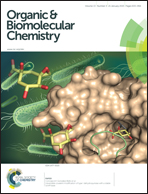Hydrolytic inhibition of α-chymotrypsin by 2,8,14,20-tetrakis(d-leucyl-d-valinamido)resorc[4]arenecarboxylic acid: a spectroscopic NMR and computational combined approach†
Abstract
The stereochemical features of 2,8,14,20-tetrakis(D-leucyl-D-valinamido)resorc[4]arenecarboxylic acid and the N-succinyl-L-alanyl-L-alanyl-L-prolyl-L-phenylalanine-4-nitroanilide polypeptide substrate were investigated by nuclear magnetic resonance spectroscopy. Proton selective relaxation parameters gave the basis for the inhibitory activity of resorcin[4]arene in the hydrolysis of the polypeptide substrate by α-chymotrypsin. Results showed that an interaction between the resorcin[4]arene and α-chymotrypsin does occur, and involves the hydrophobic moiety of the macrocycle. This interaction is further reinforced by polar groups located on the side chains of the resorcin[4]arene, whereas the macrocycle–polypeptide substrate interaction is negligible. Conformational analysis and interaction studies carried out by molecular modeling are in good agreement with the NMR data, thus providing an additional support to the rationalization of the inhibitory potential of resorcin[4]arenes on the α-chymotrypsin activity.
![Graphical abstract: Hydrolytic inhibition of α-chymotrypsin by 2,8,14,20-tetrakis(d-leucyl-d-valinamido)resorc[4]arenecarboxylic acid: a spectroscopic NMR and computational combined approach](/en/Image/Get?imageInfo.ImageType=GA&imageInfo.ImageIdentifier.ManuscriptID=C4OB01936A&imageInfo.ImageIdentifier.Year=2015)

 Please wait while we load your content...
Please wait while we load your content...